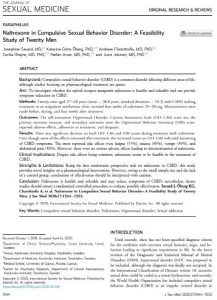Legal Considerations
Naltrexone in Compulsive Sexual Behavior Disorder: A Feasibility Study of Twenty Men
 Full Article Title: Naltrexone in Compulsive Sexual Behavior Disorder: A Feasibility
Full Article Title: Naltrexone in Compulsive Sexual Behavior Disorder: A Feasibility
Study of Twenty Men
Open Access: No
Abstract
Background: Compulsive sexual behavior disorder (CSBD) is a common disorder affecting different areas of life, although studies focusing on pharmacological treatment are sparse.
Aim: To investigate whether the opioid receptor antagonist naltrexone is feasible and tolerable and can provide symptom reduction in CSBD.
Methods: Twenty men aged 27–60 years (mean = 38.8 years, standard deviation = 10.3) with CSBD seeking treatment in an outpatient nonforensic clinic received four weeks of naltrexone 25–50 mg. Measurements were made before, during, and four weeks after treatment.
Outcomes: The self-assessment Hypersexual Disorder: Current Assessment Scale (HD: CAS) score was the primary outcome measure, and secondary outcomes were the Hypersexual Behavior Inventory (HBI) score, reported adverse effects, adherence to treatment, and dropouts.
Results: There was significant decrease on both HD: CAS and HBI scores during treatment with naltrexone. Even though some of the effects remained after treatment, the increased scores on HD: CAS indicated worsening of CSBD symptoms. The most reported side effects were fatigue (55%), nausea (30%), vertigo (30%), and abdominal pain (30%). However, there were no serious adverse effects leading to discontinuation of naltrexone.
Clinical Implications: Despite side effects being common, naltrexone seems to be feasible in the treatment of CSBD.
Strengths & Limitations: Being the first nonforensic prospective trial on naltrexone in CSBD, this study provides novel insights on a pharmacological intervention. However, owing to the small sample size and the lack of a control group, conclusions of effectiveness should be interpreted with caution.
Conclusion: Naltrexone is feasible and tolerable and may reduce symptoms of CSBD; nevertheless, future studies should ensure a randomized controlled procedure to evaluate possible effectiveness.
